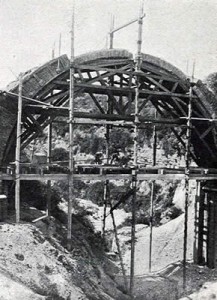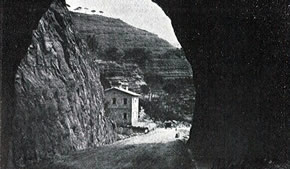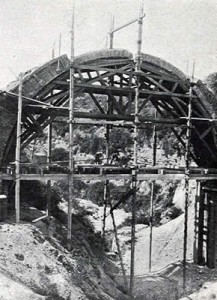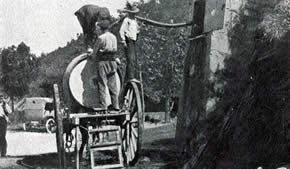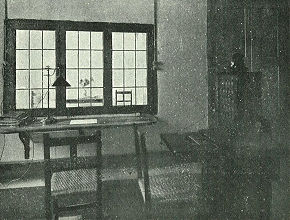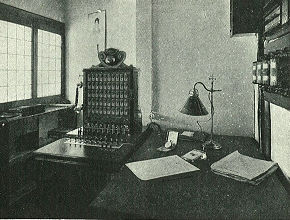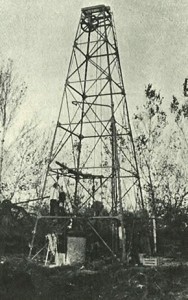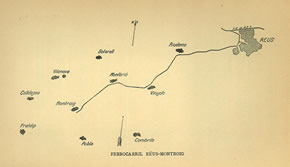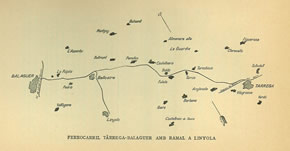A well connected land
Public communications are of paramount importance. They are the true vehicle that brings civilization. The Mancomunitat built 1,700 km of roads. It also brought telephone service to 500 towns in Catalonia, thanks to a network of telephone lines over 5,500 km long. In spite of these difficulties, the Mancomunitat undertook railroad projects and waterworks.
One hundred years later, the Diputació of Barcelona is greatly indebted to the public works projects completed by the Mancomunitat, and they repair and manage 1,600 km of roads, trails, and bridges.
Roads, trails, and bridge maintenance
On January 1, 1915, the technical department for public works was established, and the Mancomunitat put them in charge of maintaining roads that depended on the diputacions of Girona, Lleida, and Tarragona in good condition. The Mancomunitat would not be in charge of roads in Barcelona until January 1, 1916. From that point on, the Mancomunitat of Catalonia would be able to develop a comprehensive public works plan.
Among the completed projects, noteworthy ones were the placing of milestones every kilometer and every one hundred kilometers on roads and trails belonging to the diputacions of Girona, Lleida, and Tarragona; the placing of all kinds of road signs, from the ones indicating the name of towns when entering and exiting them, to signs on forks of the road and beginning of roads. These last ones were also used to warn people that they were close to a place they needed to have extra care in order to avoid an accident, such as railroad crossings with barriers, other roads, dangerous fords, sharp curves, or windy roads.
Every year, during the appropriate season, trees planted right next to roads and trails were checked for problems. They were periodically pollarded or pruned, and the fruit they yielded was harvested and sold in public auctions.
Town roads and trails repairs and improvements
Once all services were transferred in 1920, with the exception of those pertaining by law to other corporations, every year roads in need of repair were chosen after a public auction was held between the towns and service companies interested in the projects.
Scenic Trails
In some high mountain regions, there are old animal trails that, due to the special circumstances in the towns and lands they go through, became essential to having access and enjoying the surrounding landscape. The Assembly of the Mancomunitat, in its eighth meeting, approved a list of some of these trails for reconstruction, for a total of 540 kilometers, all of them having in common a strong emphasis on mountain tourism.
Building of roads, trails, and bridges
Right after the Mancomunitat was established, the Permanent Council debated about the need and opportunity of applying to the second public offer of subsidies for the construction of local roads and small bridges that had just been issued by the Spanish government.
In November 21, 1914, the Spanish government signed an agreement which granted the Mancomunitat the right to build a certain number of town roads and bridges all over Catalonia, although it was part of the subsidies from the Spanish government to the four provinces, and limited by a series of conditions predetermined by both parties.
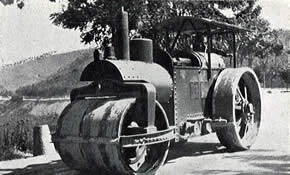
16-ton gasoline engine steamroller.
Trail from Folgueroles to Vilanova de Sau – View of the road workers house just outside the tunnel
Bridge of Bruchs
Water tank cart loading up directly from the water cistern.
Photographs from the book L’obra realitzada: anys 1914-1923 / Mancomunitat de Catalunya (Works completed: Years 1914-23 / Mancomunitat of Catalonia)
Author: Mancomunitat of Catalunya.
Year of publication: 1923.
Telephone
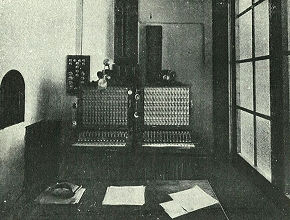
Telephone station in Figueres
Telephone station in Piera
Telephone station in Sant Feliu de Llobregat
Photographs from the book L’obra realitzada: anys 1914-1923 / Mancomunitat de Catalunya (Works completed: Years 1914-23 / Mancomunitat of Catalonia)
Author: Mancomunitat of Catalunya.
Year of publication: 1923.
Water Works
Water works for setting up and improving irrigation
Once it was established, the Mancomunitat of Catalonia tried to look for the resources necessary to promote water works in order to increase Catalonia’s arable land, and to encourage individuals to use water more efficiently for better agricultural results.
In October 14, 1915, the Council announced a public program intended to promote water works. It established that private owners, cooperatives, or workers’ associations who were interested in creating or expanding irrigation systems should apply to receive support from the Council of the Mancomunitat.
Drinking water supply to towns of less than 4000 inhabitants
On Febrary 26, 1921, the Assembly of the Mancomunitat agreed to give powers to the Permanent Council in order to accept project proposals to provide drinking water in any amount and under the pertinent prerequisites, and benefiting towns of less than 4000 people. This agreement finally materialized when, on April 21 of the same year, the Permanent Council announced a public program for towns in Catalonia who met these criteria.
March and pond clean-up
The Mancomunitat was also in charge of clean-up tasks in several places in Catalonia, not just from a health point of view, but also in order to benefit from increased farming land and to take advantage of large tracts of land that were either infertile, badly farmed, or even dangerous.
Artesian well drilling
The Permanent Council, in its June 22, 1915 meeting, agreed to commission a study to Dr. Faura, professor of geology at the Agricultural School, to determine what areas in Catalonia would be good candidates for the drilling of functional artesian wells, as well as the study of various related systems.
Local railroads projects
In June 1919, only a fraction of Catalonia had roads. The increasing need to phase out transportation by horse-drawn carriages (which did not meet the country’s production demands) in favor of railroad transportation compelled the Council of the Mancomunitat to find a way to set up an adequate railroad network in Catalonia.
The Council of the Mancomunitat, in order to honor the agreements of the Assembly, set out public bids to determine the order of preference of the various projects, from their approval, to construction bids, with the towns, individuals, banks, and companies involved in the building of Catalonia’s local railroad system.
The Permanent Council finally agreed with the proposals that explained why some of these projects deserved preferential treatment and the cooperation and financial backing from the Mancomunitat. These were the lines from Reus to Montroig, from Tarragona to Pons, from Lleida to Fraga, and from Tàrrega to Balaguer.
On June 17, 1920, the preliminary project put together by the board of experts of the line Reus-Montroig was approved.








